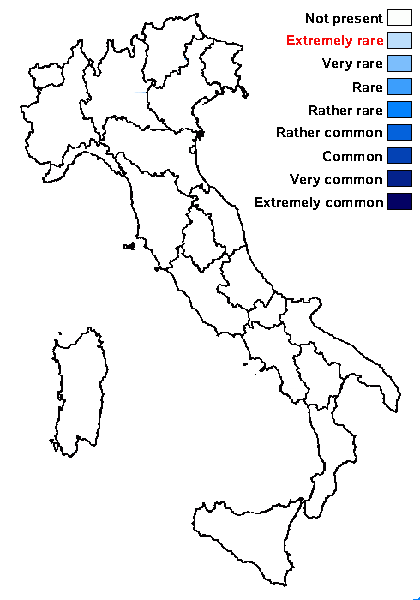Bacidina tenella (Kullh.) S. Ekman
Nordic J. Bot.: e03846, 41, 2023. Basionym: Bacidia tenella Kullh. - Not. Sällsk. Fauna Fl. Fenn. Förh., Ny Ser., 11: 273, 1871
Synonyms: Bacidia etayana (van den Boom & Vězda) Dolnik; Bacidina etayana (van den Boom & Vězda) M.Hauck & V.Wirth; Lecidea tenella (Kullh.) Nyl.; Woessia etayana van den Boom & Vězda
Distribution:
Description: Thallus crustose, episubstratic, scurfy-granular, the granules abundant, swelling in water and coalescing with age but never forming distinct soralia. Apothecia biatorine, 0.1-0.3 mm across, semi-transparent when wet, usually crowded, with a straw-coloured to brown, more or less flat disc and a darker, often blackish margin (in older apothecia the disc may become convex and concolorous with the margin). Proper exciple olive to brown in apical and marginal parts, paler within, the excipular cells up to 5 µm wide; epithecium colourless to brownish; hymenium with diffuse mixed red-brown and olivaceous hues, c. 30 µm high; paraphyses scarce, mostly simple; hypothecium colourless. Asci 8-spored, cylindrical-clavate, approaching the Bacidia-type, but the ocular chamber wider, and the axial body never penetrating through the entire d-layer, surrounded by a narrow, darker amyloid layer. Ascospores (0-)1-3-septate, hyaline, acicular, 25-40 x 1.5-2 µm. Pycnidia olive to brown. Conidia 3-septate, 20-40 x 1.5-2 µm. Photobiont chlorococcoid. Spot tests: thallus K-, C-, KC-, P-. Chemistry: thallus without lichen substances, apothecia with the Laurocerasi-brown pigment only.Note: a species described from the French Pyrenees and known from Germany, Switzerland, Scandinavia, the Czech Republic and Ukraine, growing on lignum of worked timber and snags, thin branches, dead grass and perennial leaves (Ekman 2023). To be looked for in Italy.
Growth form: Crustose
Substrata: bark and lignum
Photobiont: green algae other than Trentepohlia
Reproductive strategy: mainly sexual
Pioneer species

Predictive model
Growth form: Crustose
Substrata: bark and lignum
Photobiont: green algae other than Trentepohlia
Reproductive strategy: mainly sexual
Pioneer species

Predictive model
 Index Fungorum
Index Fungorum
 GBIF
GBIF

